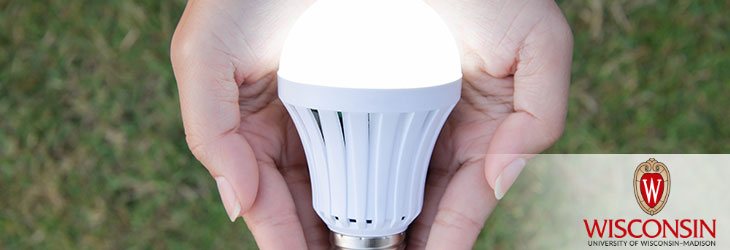Clean Technology

Rechargeable Desalination Battery
WARF: P170083US01
Inventors: Kyoung-Shin Choi, Dohwan Nam
The Wisconsin Alumni Research Foundation (WARF) is seeking commercial partners interested in developing the first practical, high capacity desalination cell using bismuth-based chloride-storage electrodes.
Overview
Access to fresh water is a pressing geopolitical issue and technological challenge. Desalination is a potentially viable solution considering the abundance of seawater on Earth. While reverse osmosis is an advanced science, the process requires significant electrical input. A promising alternative is capacitive deionization (CDI), which removes salt ions by capturing them in a double layer of high surface area electrodes.
CDI cells have been limited primarily to brackish water and are less effective at removing salt from concentrated sources like ocean water. To increase capacity, researchers know that salt ions can be stored in the bulk of the electrode through the formation of chemical bonds. Moreover, if the cell can store and release salt ions through the charging/discharging cycle and recover some of the energy in the process, it could be considered a rechargeable ‘desalination battery’ with the potential to slash overall energy input.
To date, attempts to engineer such a cell have relied on costly silver as the chloride-storage electrode. The commercial viability of the technology depends on the development of more efficient, stable and practical electrode material.
CDI cells have been limited primarily to brackish water and are less effective at removing salt from concentrated sources like ocean water. To increase capacity, researchers know that salt ions can be stored in the bulk of the electrode through the formation of chemical bonds. Moreover, if the cell can store and release salt ions through the charging/discharging cycle and recover some of the energy in the process, it could be considered a rechargeable ‘desalination battery’ with the potential to slash overall energy input.
To date, attempts to engineer such a cell have relied on costly silver as the chloride-storage electrode. The commercial viability of the technology depends on the development of more efficient, stable and practical electrode material.
The Invention
UW–Madison researchers have designed a rechargeable desalination cell that can operate on seawater and is capable of performing a desalination/salination cycle with a net potential input as low as 0.2 volts. The cell comprises a sodium-storage electrode coupled to a chloride-storage electrode made of nanocrystalline bismuth foam.
The bismuth-based electrodes are able to store chloride ions in their bulk by oxidizing Bi to BiOCl in the presence of an oxygen source, such as water. Advantageously, BiOCl is insoluble in water over a wide pH range and inert against water oxidation. It also is stable over a wide range of anodic potentials. As a result, the new electrodes can be used for chloride removal in a variety of aqueous sources.
The BiOCl electrode can be converted back to a bismuth electrode by a reduction reaction, where the chloride ions are released into the electrolyte. This reverse reaction allows for the repeated use of the electrode for chloride storage/release via multiple chlorination/dechlorination cycles.
The bismuth-based electrodes are able to store chloride ions in their bulk by oxidizing Bi to BiOCl in the presence of an oxygen source, such as water. Advantageously, BiOCl is insoluble in water over a wide pH range and inert against water oxidation. It also is stable over a wide range of anodic potentials. As a result, the new electrodes can be used for chloride removal in a variety of aqueous sources.
The BiOCl electrode can be converted back to a bismuth electrode by a reduction reaction, where the chloride ions are released into the electrolyte. This reverse reaction allows for the repeated use of the electrode for chloride storage/release via multiple chlorination/dechlorination cycles.
Applications
- Efficient and practical desalination of seawater/brackish water, or other chloride removal processes
- Could be strategically integrated with various electrochemical processes to maximize useful outcome (e.g., fresh water, energy input, H2 and Cl2) while minimizing energy overhead
Key Benefits
- Based on the use of inexpensive Bi electrodes
- Offers a desalination mechanism completely different from reverse osmosis and CDI
- Dramatically reduced requirement for electrical power
- Dramatically lower operating cost
- Commercially viable
Stage of Development
The researchers have constructed a desalination battery with the capacity to operate on seawater. They have demonstrated that the cell can perform a desalination/salination cycle with a net potential input of 0.2 volts.
The development of this technology was supported by WARF Accelerator. WARF Accelerator selects WARF's most commercially promising technologies and provides expert assistance and funding to enable achievement of commercially significant milestones. WARF believes that these technologies are especially attractive opportunities for licensing.
The development of this technology was supported by WARF Accelerator. WARF Accelerator selects WARF's most commercially promising technologies and provides expert assistance and funding to enable achievement of commercially significant milestones. WARF believes that these technologies are especially attractive opportunities for licensing.
Additional Information
For More Information About the Inventors
Related Technologies
Publications
For current licensing status, please contact Mark Staudt at [javascript protected email address] or 608-960-9845
- Nam D.-H. and Choi K.-S. 2017. Bismuth as a New Chloride-Storage Electrode Enabling the Construction of a Practical High Capacity Desalination Battery. J. Am. Chem. Soc. Epub 8.4.17. DOI: 10.1021/jacs.7b01119